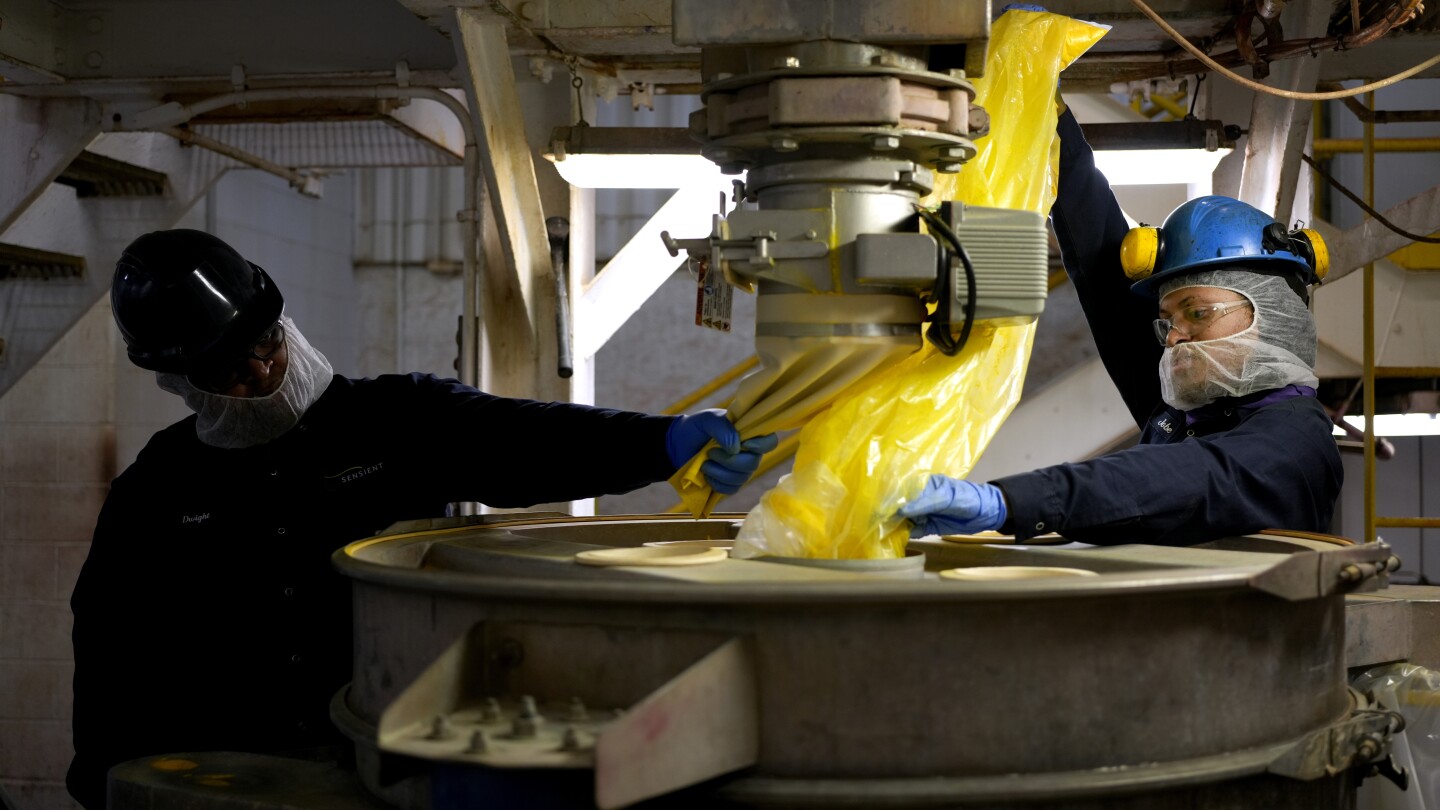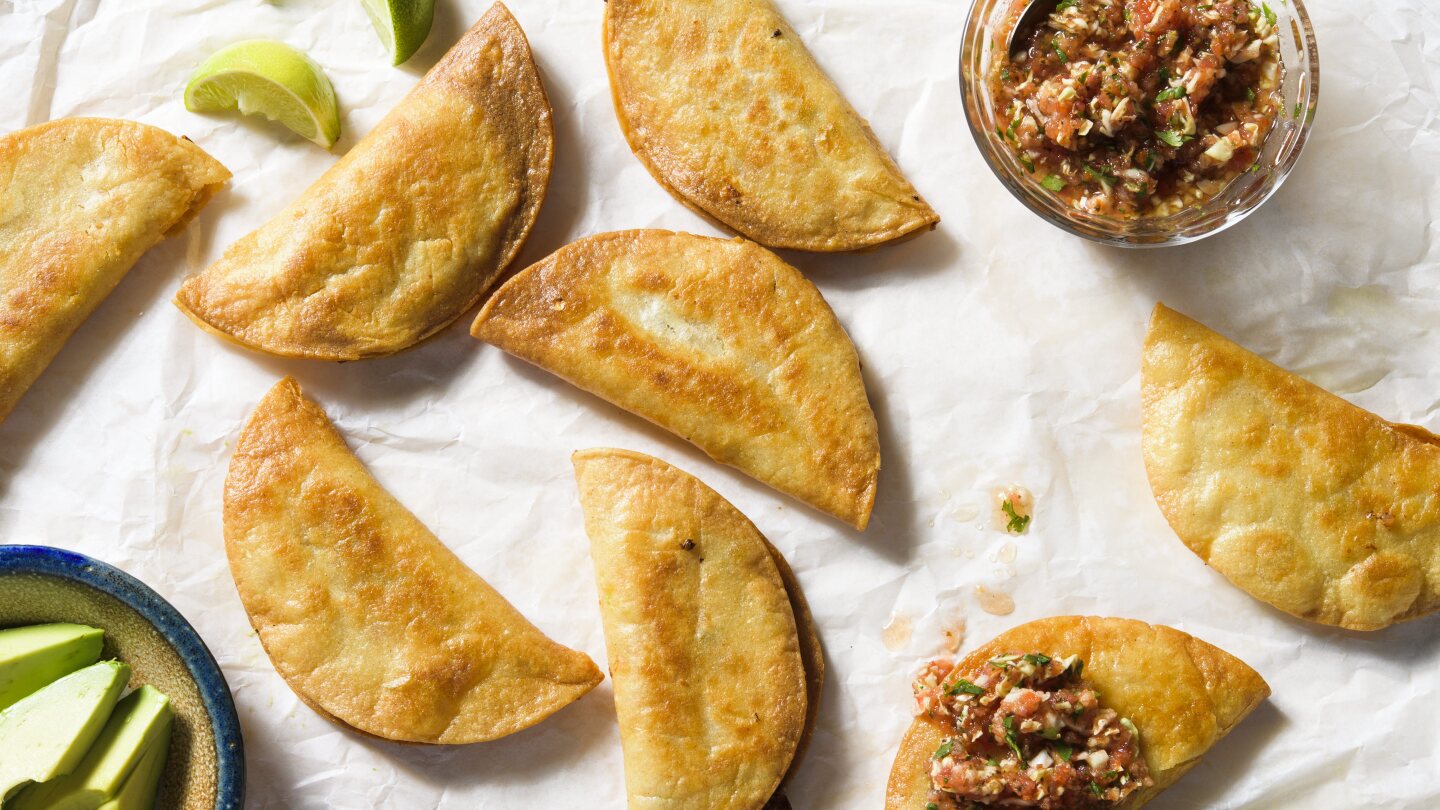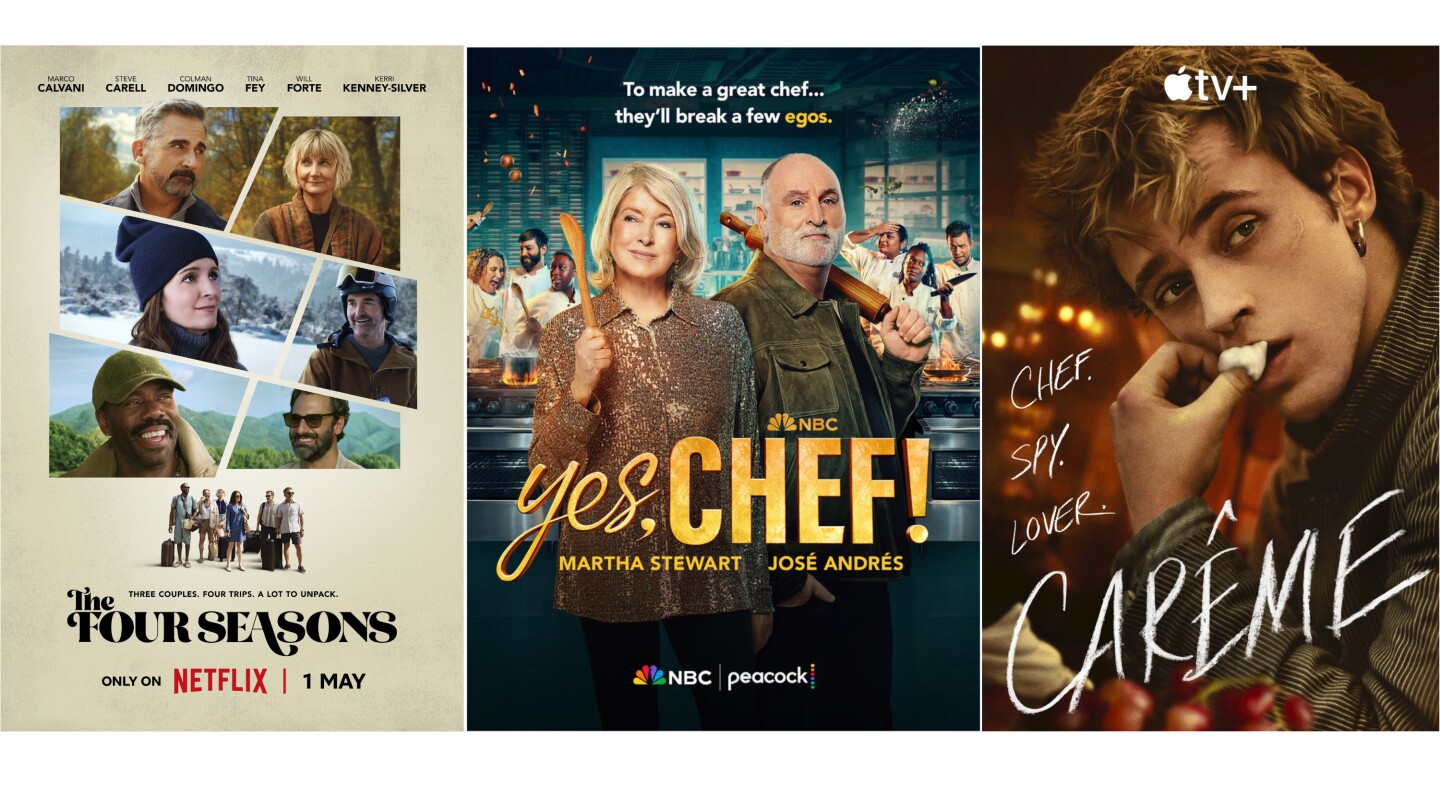Lifestyle
How bugs and beet juice could play roles in the race to replace artificial dyes in food

ST. LOUIS (AP) — As pressure grows to get artificial colors out of the U.S. food supply, the shift may well start at Abby Tampow’s laboratory desk.
On an April afternoon, the scientist hovered over tiny dishes of red dye, each a slightly different ruby hue. Her task? To match the synthetic shade used for years in a commercial bottled raspberry vinaigrette — but by using only natural ingredients.
“With this red, it needs a little more orange,” Tampow said, mixing a slurry of purplish black carrot juice with a bit of beta-carotene, an orange-red color made from algae.
Tampow is part of the team at Sensient Technologies Corp., one of the world’s largest dyemakers, that is rushing to help the salad dressing manufacturer — along with thousands of other American businesses — meet demands to overhaul colors used to brighten products from cereals to sports drinks.
“Most of our customers have decided that this is finally the time when they’re going to make that switch to a natural color,” said Dave Gebhardt, Sensient’s senior technical director. He joined a recent tour of the Sensient Colors factory in a north St. Louis neighborhood.
Last week, U.S. health officials announced plans to persuade food companies to voluntarily eliminate petroleum-based artificial dyes by the end of 2026.
Health Secretary Robert F. Kennedy Jr. called them “poisonous compounds” that endanger children’s health and development, citing limited evidence of potential health risks.
The federal push follows a flurry of state laws and a January decision to ban the artificial dye known as Red 3 — found in cakes, candies and some medications — because of cancer risks in lab animals. Social media influencers and ordinary consumers have ramped up calls for artificial colors to be removed from foods.
A change to natural colors may not be fast
The FDA allows about three dozen color additives, including eight remaining synthetic dyes. But making the change from the petroleum-based dyes to colors derived from vegetables, fruits, flowers and even insects won’t be easy, fast or cheap, said Monica Giusti, an Ohio State University food color expert.
“Study after study has shown that if all companies were to remove synthetic colors from their formulations, the supply of the natural alternatives would not be enough,” Giusti said. “We are not really ready.”
It can take six months to a year to convert a single product from a synthetic dye to a natural one. And it could require three to four years to build up the supply of botanical products necessary for an industrywide shift, Sensient officials said.
“It’s not like there’s 150 million pounds of beet juice sitting around waiting on the off chance the whole market may convert,” said Paul Manning, the company’s chief executive. “Tens of millions of pounds of these products need to be grown, pulled out of the ground, extracted.”
To make natural dyes, Sensient works with farmers and producers around the world to harvest the raw materials, which typically arrive at the plant as bulk concentrates. They’re processed and blended into liquids, granules or powders and then sent to food companies to be added to final products.
Natural dyes are harder to make and use than artificial colors. They are less consistent in color, less stable and subject to changes related to acidity, heat and light, Manning said. Blue is especially difficult. There aren’t many natural sources of the color and those that exist can be hard to maintain during processing.
Also, a natural color costs about 10 times more to make than the synthetic version, Manning estimated.
“How do you get that same vividness, that same performance, that same level of safety in that product as you would in a synthetic product?” he said. “There’s a lot of complexity associated with that.”
The insects that could make ‘Barbie pink’ naturally
Companies have long used the Red 3 synthetic dye to create what Sensient officials describe as “the Barbie pink.”
To create that color with a natural source might require the use of cochineal, an insect about the size of a peppercorn.
The female insects release a vibrant red pigment, carminic acid, in their bodies and eggs. The bugs live only on prickly pear cactuses in Peru and elsewhere. About 70,000 cochineal insects are needed to produce 1 kilogram, about 2.2 pounds, of dye.
“It’s interesting how the most exotic colors are found in the most exotic places,” said Norb Norbrega, who travels the world scouting new hues for Sensient.
Artificial dyes are used widely in U.S. foods. About 1 in 5 food products in the U.S. contains added colors, whether natural or synthetic, Manning estimated. Many contain multiple colors.
FDA requires a sample of each batch of synthetic colors to be submitted for testing and certification. Color additives derived from plant, animal or mineral sources are exempt, but have been evaluated by the agency.
Health advocates have long called for the removal of artificial dyes from foods, citing mixed studies indicating they can cause neurobehavioral problems, including hyperactivity and attention issues, in some children.
The U.S. Food and Drug Administration says that the approved dyes are safe when used according to regulations and that “most children have no adverse effects when consuming foods containing color additives.”
But critics note that added colors are a key component of ultraprocessed foods, which account for more than 70% of the U.S. diet and have been associated with a host of chronic health problems, including heart disease, diabetes and obesity.
“I am all for getting artificial food dyes out of the food supply,” said Marion Nestle, a food policy expert. “They are strictly cosmetic, have no health or safety purpose, are markers of ultraprocessed foods and may be harmful to some children.”
The cautionary tale of Trix cereal
Color is powerful driver of consumer behavior and changes can backfire, Giusti noted. In 2016, food giant General Mills removed artificial dyes from Trix cereal after requests from consumers, switching to natural sources including turmeric, strawberries and radishes.
But the cereal lost its neon colors, resulting in more muted hues — and a consumer backlash. Trix fans said they missed the bright colors and familiar taste of the cereal. In 2017, the company switched back.
“When it’s a product you already love, that you’re used to consuming, and it changes slightly, then it may not really be the same experience,” Giusti said. “Announcing a regulatory change is one step, but then the implementation is another thing.”
Kennedy, the health secretary, said U.S. officials have an “understanding” with food companies to phase out artificial colors. Industry officials told The Associated Press that there is no formal agreement.
However, several companies have said they plan to accelerate a shift to natural colors in some of their products.
PepsiCo CEO Ramon Laguarta said most of its products are already free of artificial colors, and that its Lays and Tostitos brands will phase them out by the end of this year. He said the company plans to phase out artificial colors — or at least offer consumers a natural alternative — over the next few years.
Representatives for General Mills said they’re “committed to continuing the conversation” with the administration. WK Kellogg officials said they are reformulating cereals used in the nation’s school lunch programs to eliminate the artificial dyes and will halt any new products containing them starting next January.
Sensient officials wouldn’t confirm which companies are seeking help making the switch, but they said they’re ready for the surge.
“Now that there’s a date, there’s the timeline,” Manning said. “It certainly requires action.”
___
Dee-Ann Durbin contributed reporting from Detroit.
___
The Associated Press Health and Science Department receives support from the Howard Hughes Medical Institute’s Science and Educational Media Group and the Robert Wood Johnson Foundation. The AP is solely responsible for all content.
Lifestyle
Celebrate Cinco de Mayo with crisp-fried shrimp tacos

Shrimp is payday food for many, but Raul Ortega figured out how to make the shrimp taco affordable by using fewer shrimp while optimizing flavor. At Mariscos Jalisco, Ortega’s food truck in the Boyle Heights area of Los Angeles, the tacos de camarón, or shrimp tacos, are the main attraction.
Ortega stuffs a perfectly seasoned shrimp filling into tortillas and fries the tacos to golden crispness before finishing them with tomato salsa and avocado. His recipe is a closely guarded secret, but for the recipe in our cookbook “ Milk Street 365: The All-Purpose Cookbook for Every Day of the Year,” we got some help replicating it from recipe developer Paola Briseño-González.
To get that same delicious melding of flavors and textures, the shrimp are chopped in a food processor, then cooked with a flour-thickened tomato-onion purée to make the filling. Though the recipe specifies shrimp of a certain size, just about any will work. It’s easy enough for a weeknight, but special enough for a Cinco de Mayo celebration.
Don’t try to bypass the step of warming the tortillas before filling them. Straight from the package, the tortillas likely will be brittle and will crack when folded. After warming the tortillas, be sure to keep them wrapped in a towel so they remain pliable until you’re ready to fill the tacos.
Fried Shrimp Tacos with Salsa Roja
Start to finish: 1¼ hours
Servings: Makes 8 tacos
Ingredients:
For the salsa roja:
1 pound ripe plum tomatoes, cored, halved and seeded
¼ large white onion, chopped (about ½ cup)
2 medium garlic cloves, smashed and peeled
1 tablespoon dried Mexican oregano
Kosher salt and ground black pepper
1 cup finely chopped green cabbage
1 cup lightly packed fresh cilantro, chopped
___
For the tacos and serving:
8 ounces ripe plum tomatoes, cored, halved and seeded
¾ large white onion, chopped (about 1 heaping cup)
2 medium garlic cloves, smashed and peeled
1 teaspoon dried Mexican oregano
Kosher salt and ground black pepper
8 ounces large (26/30 per pound) shrimp (see headnote), peeled (tails removed) and deveined
3 tablespoons plus 1 cup grapeseed or other neutral oil, divided
3 tablespoons all-purpose flour
Eight 6-inch corn tortillas
1 ripe avocado, halved, pitted, peeled and sliced
Lime wedges, to serve
Directions:
To make the salsa, in a food processor, combine the tomatoes, onion, garlic, oregano and 1 teaspoon salt. Process until smooth, 1 to 2 minutes. Transfer to a medium bowl; reserve the food processor bowl and blade. Stir the cabbage and cilantro into the puree, then taste and season with salt and pepper. Cover and set aside until ready to serve.
To make the tacos, in the food processor, combine the tomatoes, onion, garlic, oregano, 1 teaspoon salt and ¼ teaspoon pepper. Pulse to a coarse puree, about 10 pulses. Transfer to a small bowl. To the food processor, add the shrimp and pulse until finely chopped, about 4 pulses.
In a 10-inch skillet over medium, heat the 3 tablespoons oil until shimmering. Add the tomato-onion puree and cook, stirring occasionally, until most of the moisture has evaporated, 7 to 9 minutes. Add the flour and cook, stirring, until well incorporated, about 1 minute. Add the shrimp and cook, stirring constantly, until the shrimp turn pink and the mixture has thickened, about 1 minute. Set aside off heat.
Heat a 12-inch skillet over medium until water flicked onto the surface immediately sizzles and evaporates. Add 2 tortillas in a single layer (it’s fine if they overlap slightly) and heat, flipping them once, until warm, about 30 seconds per side. Transfer to a kitchen towel and wrap loosely to keep warm and pliable. Repeat with the remaining tortillas, stacking and wrapping them in the towel. Add the remaining 1 cup oil to the skillet; keep warm over low while you fill the tortillas.
Lay 4 of the tortillas on a work surface and divide half of the shrimp mixture evenly among them, placing the filling on one side of the tortilla. Fold the unfilled sides over and press lightly; leave the edges open (do not seal them). Fill the remaining tortillas with the remaining shrimp mixture in the same way.
Return the oil to medium and heat until shimmering (about 350°F). Carefully add 4 of the tacos and cook until golden brown and crisp on the bottoms, about 3 minutes. Using a thin metal spatula, flip each taco and cook until golden brown on the second sides, about 3 minutes, then transfer to a paper towel-lined plate. Fry the remaining tacos in the same way, adjusting the heat as needed.
Transfer the tacos to a serving platter and spoon on some of the salsa. Top with the avocado slices and serve with the remaining salsa and lime wedges on the side.
EDITOR’S NOTE: For more recipes, go to Christopher Kimball’s Milk Street at 177milkstreet.com/ap
Lifestyle
What to Stream: Tina Fey and Steve Carell, Martha Stewart and José Andrés, and Maddie & Tae

NEW YORK (AP) — Blake Lively and Anna Kendrick going to Italy for a wedding and some mafia intrigue in the movie “Another Simple Favor” and Tina Fey and Steve Carell reuniting for the Netflix series “The Four Seasons” are some of the new television, films, music and games headed to a device near you.
Also among the streaming offerings worth your time, as selected by The Associated Press’ entertainment journalists: Season 2 of “The Walking Dead: Dead City” lumbers into view, RaMell Ross’ shattering movie “Nickel Boys” and country music duo Maddie & Tae return with another album full of good-time anthems.
New movies to stream from April 28-May 4
— Murder, betrayal and martinis are on the menu for “Another Simple Favor,” which brings Blake Lively and Anna Kendrick’s characters to Italy for a wedding, and some mafia intrigue. Paul Feig returned to the director’s chair for the film which got largely favorable reviews out of the South by Southwest Film Festival. “Another Simple Favor” premieres on Prime Video on May 1.
— Also coming to Prime Video is one of the best movies of 2024, RaMell Ross’ shattering “Nickel Boys,” which begins streaming on April 29. The adaptation of Colson Whitehead’s Pulitzer-winning novel employs a first-person point of view to tell the story of two boys at a brutal reform school in the Jim Crow South. In my review, I wrote that it was “formally and emotionally eye-opening,” a memory piece and “a reconciling of unspeakable traumas and human resilience.” It was Oscar nominated for best picture and best adapted screenplay.
— There’s another gem streaming on MUBI on Friday, May 2, but this is likely one most haven’t heard of. The independent film “La Cocina” flew under the radar with a modest release, but it’s worth a watch for anyone who loves innovative cinema. Directed by Alonso Ruizpalacios, “La Cocina” is an artistic behind-the-scenes look at a kitchen staff during the lunch rush at a busy Times Square restaurant. The tension is ramped up due to missing money and interpersonal drama between an undocumented chef (Raúl Briones) and the waitress he loves (Rooney Mara).
— AP Film Writer Lindsey Bahr
New music to stream from April 28-May 4
— In a recent viral interview, the innovative Swedish rapper Yung Lean declared “the party is over.” In the music video for “Forever Yung,” the lead single from his forthcoming record, he takes that spirit quite literally and holds a funeral for himself. It’s a sinisterly cheerful affair, bolstered by the song’s lo-fi production and reverbed vocals. His latest album, “Jonatan” — taken from his real name Jonatan Leandoer Håstad — arrives Friday via World Affairs.
— Country music duo Maddie & Tae return with another album full of good-time anthems titled “Love & Light,” their latest for Mercury Nashville/UMG. “Drunk Girls in Bathrooms” might be the most romantic song written about a glorious five-minute friendship; “Kissing Cowboys” sounds like a raucous good time in a crowded dive bar. It is the soundtrack to a summertime road trip with girlfriends.
— Isaiah Falls, a fresh voice in R&B, will release the A-side to his debut album, “LVRS PARADISE” on Friday. The rising talent brings Southern Florida bounce to his smooth vocal performances.
— Music Writer Maria Sherman
New television to stream from April 28-May 4
— Tina Fey and Steve Carell — who teamed up in 2010 for “Date Night” — are reuniting again for the upcoming Netflix series “The Four Seasons.” Based on the 1981 movie of the same name, “The Four Seasons” is a comedy-drama about three couples who take four yearly vacations together, one for each season. Fey and Carell are joined by Will Forte, Colman Domingo, Marco Calvani and Kerri Kenney-Silver. Fey co-created “The Four Seasons” with her “30 Rock” collaborators Lang Fisher and Tracey Wigfield. It starts Thursday.
— Season 2 of “The Walking Dead: Dead City” lumbers into view Sunday, May 4 on AMC. One of six “Walking Dead” spin-offs produced so far, “Dead City” reunites the show’s unlikely duo — Negan, played by Jeffery Dean Morgan, and Maggie, played by Lauren Cohan. They are trying to survive in a post-apocalyptic Manhattan, long since isolated from the mainland. New faces joining the cast include Kim Coates (Sons of Anarchy) as the menacing Bruegel, Keir Gilchrist (Atypical) as Benjamin Pierce, and Dascha Polanco (Orange Is the New Black) as Major Lucia Narvaez.
— Apple TV+ hits the kitchen Wednesday with “Carême,” a French historical drama that’s being called “The Bear” crossed with “The Bourne Identity.” It tells the story of Marie-Antonin Carême, often called the father of French cuisine, as he climbs to the height of culinary stardom in Napoleon’s Europe. It’s not just a food show — our hero must also navigate the volatile world of shifting political alliances, royal secrets and revolution-fueled suspicions.
— NBC is also heading to the kitchen with “Yes, Chef!,” a new cooking competition that pairs Martha Stewart and José Andrés. The show pits 12 professional chefs and Stewart and Andrés will judge their cooking skills and ability to work together as they complete in a series of high-stakes culinary challenges. The top chef will take home a $250,000 grand prize. “Yes, Chef!” premieres Monday and streams on Peacock a day later.
— AP Entertainment Writer Mark Kennedy
New video games to play week of April 28-May 4
— Skin Deep isn’t the sort of title you’d expect from California’s Blendo Games, a one-man studio that has blessed us with gonzo cult hits like Quadrilateral Cowboy and Thirty Flights of Loving. But designer Brendon Chung’s signature weirdness is all over the story, in which insurance agent Nina Pasadena has to rescue a bunch of frozen cats from space pirates. The bad guys are well-armed but Nina isn’t, so she’ll have to use whatever’s at hand — broken glass, banana peels, boxes of ragweed — to take them down before she can hurl them out the airlock. It’s like “Die Hard” on a space station with a healthy dose of slapstick, and it launches Wednesday on PC.
— Lou Kesten
Lifestyle
Campgrounds and visitor centers at federal lakes are closing amid Trump’s budget cuts

TOPEKA, Kan. (AP) — Campgrounds, boat ramps and other facilities in at least 30 locations at federal lakes and reservoirs in six states will be closed or have their hours curtailed as of mid-May as the Trump administration tries to rapidly shrink the U.S. government.
Officials at the U.S. Army Corps of Engineers, which oversees the lakes and reservoirs and their amenities for boating, camping, hiking and sightseeing, said they are dealing with staffing shortages and other budgetary restrictions.
Corps spokesman Douglas Garman said concentrating staff at fewer recreational sites will allow those sites to keep the “full range of services” that visitors expect.
The Corps’ district office in Omaha, Nebraska, which oversees facilities across a large swath of the Great Plains from western Iowa and Nebraska to Montana’s border with Canada, said the changes also will protect hydropower and dam operations.
“Decisions to make operational changes at recreation areas are not made lightly, and we understand those decisions can be disruptive to the public’s travel plans,” Garman said in an email to The Associated Press.
President Donald Trump imposed a federal hiring freeze after beginning his second term in January, and his Department of Government Efficiency is trying to eliminate tens of thousands of government jobs.
In Pickstown, South Dakota, residents were “appalled” to learn the Corps plans to close its visitor center at the Fort Randall Dam and suspend tours of the dam’s powerhouse on May 1, said Cindy Broyhill, the president of the town’s Board of Trustees.
“”We have a lot of fishing and boating, but we also have a lot of just plain tourists coming through to see the dam,” Broyhill said of Pickstown, located a little more than a half-mile (0.8 kilometers) east of the dam on the Missouri River, about 4 miles (6.4 kilometers) north of the Nebraska state line.
“I think there are other places where they could cut that would make more sense,” she added.
In western Kansas, Sue Graham, manager of Knothead’s bait shop and camping supply store on the east side of Wilson Lake, was skeptical of a plan to limit a campsite there to daytime use as of May 15. The lake is about 230 miles (370 kilometers) west of Kansas City, home to the Corps district office for parts of Kansas, Missouri and southern Nebraska.
Graham doesn’t think the move will save much money because the campsite is used only by residents who own boat ramps nearby, but Corps officials would “shoot themselves in the foot” if they went further because of lost fee revenues, she said, adding that she does not expect her shop to be affected.
“People are still going to come out,” Graham said.
The Kansas City district plans to close visitor information centers at two Kansas lakes including Hillsdale, outside the Kansas City area, and Kanopolis, in central Kansas. The Corps will not allow overnight camping in 25 “primitive,” no-amenities spots in two areas at Harlan County Lake in western Nebraska near the Kansas state line. The sites and water nearby still will be accessible during the day.
Emily Coffin, the district’s natural resource section chief, said the district has pursued efficiency initiatives for five or six years that will lead to fewer visitor-staff interactions. They include self-service campsite registrations, cashless parking and payments through codes scanned with smartphones.
“It just may be a little bit more noticeable because we have more of that built on than maybe we did two years ago,” she said.
In March, the Corps’ Baltimore district closed three campgrounds at Raystown Lake in central Pennsylvania and a campground, swimming beach and boat ramp at Cowanesque Lake in northern Pennsylvania.
The Omaha district announced earlier this month that it would close six campgrounds in the Dakotas on May 1, as well as three visitor centers in South Dakota and Montana. It also plans to suspend or limit tours of four South Dakota dam powerhouses and decrease tours at Fort Peck Dam in northeast Montana.
The Corps district for southeastern Washington state announced last week it was closing two visitor centers and eight camping and recreation areas there.
“By concentrating our resources, we can better maintain essential missions,” Lt. Col. Katie Werbeck, the district’s commander, said in a statement.
-

 Sports2 days ago
Sports2 days agoBoston Celtics criticize Orlando Magic’s physicality after another injury in Game 3 loss
-

 Sports2 days ago
Sports2 days agoLondon Marathon: Why more people than ever before are running marathons
-

 Europe2 days ago
Europe2 days agoTrump dreams of empire while struggling to keep some promises
-

 Sports1 day ago
Sports1 day agoNew England Patriots make Kobee Minor this year’s ‘Mr. Irrelevant’
-

 Europe1 day ago
Europe1 day agoFrancis celebrated as ‘pope among the people’ in Vatican funeral attended by massive crowd
-

 Middle East1 day ago
Middle East1 day agoDeadly explosion shakes Iran, hundreds hospitalised after port fire | Gallery News
-

 Africa1 day ago
Africa1 day agoUganda declares end to Ebola outbreak
-

 Lifestyle2 days ago
Lifestyle2 days agoWhite House journalists use annual press dinner to celebrate First Amendment




